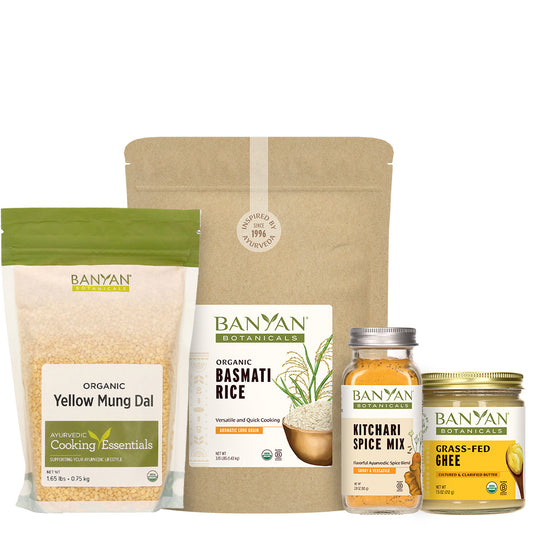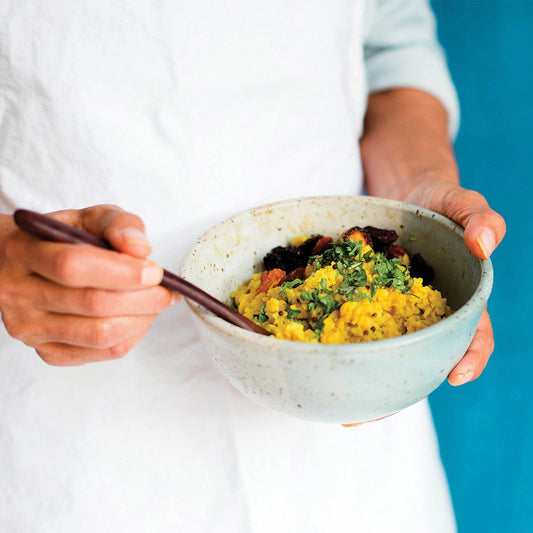Summer is pitta season. Pitta means heat. So when summer comes there are six particular foods I rely on to stay cool.
They are wonderful any day during summer, and any season for summer people (meaning people of pitta constitution. Don't know your constitution? Take a moment to create your Ayurvedic profile.)
In fact, these six are so fundamental to Ayurveda and its approach to “hot bodies” that they could be considered the ABCCCDs of summer!

Aloe
The Egyptians referred to aloe as the “plant of immortality” and placed it among the funerary gifts buried with the pharaohs. The Chinese, Greeks, and Romans also treasured aloe for its traditional uses for supporting healthy skin.
The leaves of aloe vera are made up of a clear, soothing, viscous gel that is 96% water. In addition to the skin, aloe helps support the health of other epitheliums in our body including the lining of the gut, the bronchial tubes, and the genital tract. When taken internally, aloe vera can support digestion and the absorption of nutrients while clearing natural toxins out of the GI tract. It is also shown to help maintain blood sugar levels already in the normal range, support energy production, purify blood, promote cardiovascular health, bolster liver function, encourage cellular renewal, and boost the immune system. Ayurvedically speaking, aloe cools your internal fires.
- For skin and digestive health, take 1 tablespoon of aloe juice in the morning.
- One of my favorite smoothies, the Green Goddess Morning Glory, features aloe as a key ingredient.
- For a very simple tonic, mix together 1/3 cup aloe juice with 1/2 cup water and 1 tablespoon black cherry concentrate to make an aloe drink which you can have as a morning wake-me-up, or about an hour before bed as an evening tonic to help cool down and ease you into sleep.
Please note: Pregnant women and children under five should not take aloe vera internally.
Burdock
Burdock is bitter, pungent, and astringent. According to Dr. David Frawley {The Yoga of Herbs}, burdock has a strong action to maintain water balance and cleanse natural toxins, yet with nutritive properties that make it a tonic and rejuvenative for pitta. It can even calm high pitta emotions such as anger, aggression, and ambition.
Burdock is known as a good blood purifier. It has been said that Native Americans used it for venomous bites, although there isn't current research or testing to support this claim.
- You can put a handful of burdock root pieces in a teapot in the morning, pour boiling water up to the rim (4 cups), and stir in a small fist of hand-crushed mint leaves. Let it cool to room temperature, then pour through a strainer into a glass. If it is too bitter, stir in a teaspoon of maple syrup. Optionally, you can add a few seeds of fennel while boiling for a sweeter taste, and a cooling digestive boost.
- You can also add burdock to soups and stews. Just toss it in early and cook long enough for it to soften.
* I purchase burdock root in the bulk section of my local fresh market.

Cilantro
Cilantro is called coriander in most parts of the world including India, where Ayurveda originated thousands of years ago. In the US, coriander just refers to the cilantro seed.
Ayurveda considers cilantro to be sweet, astringent, and cold, making it an antidote to hot and sour foods as well as hot and sour physical issues and emotions. Cilantro supports the skin, the digestive fire, and intestinal calm and comfort.
Coriander, the seed of cilantro, is a mild diuretic and helps soothe and tone the urinary tract.
Cilantro/coriander promotes proper functioning of the liver and, as a beneficial source of dietary fiber, it facilitates balanced bowel movements.
- Cilantro is so good for you. I add it to just about everything and I love making this Cilantro Pesto for pasta and salads.
- You can make a cooling and revitalizing juice by blending handfuls of fresh cilantro, stems and all, with water. Blend until it is thoroughly liquefied, then strain and drink the juice. The remaining pulp can be used as a poultice.
- As a poultice, cilantro pulp can be applied topically to irritated skin to help soothe and support healing. To make a poultice, wash 1 bunch of cilantro, pick out the brown or spoiled leaves and put the rest in a high-speed blender. You can use the stems as well as the leaves. Add 1/2 cup water and blend on high until the cilantro is thoroughly liquefied. Strain, saving the liquid to add to a broth or a cooling summer refresher. Squeeze the pulp to release as much water as possible. Apply this pulp to the irritation and cover with a wrap so it holds. Leave to dry.
Coconut
For its chill factor, coconut—grown in the hot tropics where it is practically always summer—is that perfect, hot-season food. Offering sweet, healthy hydration, coconut restores moisture, minerals, and electrolytes.
- Coconut's sweet taste perfectly balances hot spices, and its creamy texture makes it a delicious substitute for milk in recipes. You can add it to mint tea for a summer afternoon “pick-me-up,” or to any smoothie instead of ice, to give your body a cooling sensation without dousing your digestive fire.
- One of my favorite recipes for summer blends coconut milk with almond butter, a bit of tamari, and a teaspoon of ginger paste to taste. Measure the ingredients to your own taste to make a dressing you can toss with basmati rice, sautéed vegetables, salad, or buckwheat noodles.
- Coconut's natural sweetness helps you reduce the need to add sugar to your breakfast or desserts. This Coconut Mango Cobbler gives all the sweet, juicy refreshment of summer, with just a bit of coconut sugar per serving.

Cucumber
When it comes to therapeutic summer foods, cucumber is at the top of my list of thirst quenching, instant-cooling vegetables. As a diuretic, it is an effective reducer of excess heat and a good skin remedy. The moisture-promoting, juicy cucumber contains more than 90% water and is rich in minerals.
According to Rebecca Wood, author of the brilliant, must-have resource, The New Whole Foods Encyclopedia, cucumber assists in cleansing and purifying blood, positively affects the heart and stomach, and contains erepsin—a digestive enzyme that is useful in breaking down protein.
Cucumber increases kapha, but brings pacification to vata and pitta.
- Cucumber is so well appreciated for its cooling benefits that beauty experts have advocated the “cucumber slice on the eyes” treatment for centuries. Did you know your eyes are an expression of pitta in your body? So it makes sense to cool your eyes in the summer to bring down heat in your body, and cucumbers are a lovely, natural way of doing this.
- Bring cucumber peels with you on summer activities so that if you or a loved one begins to overheat, you can place a cucumber peel on the back of the neck, at the temples, or over closed eyes. Back home, whip up this Cucumber Refresher or this refreshing Persian Cucumber Salad to relax and chill.
Dandelion
Dandelion root and its greens (the whole plant is medicinal) have been used as tonics and liver support in European folk medicine since the time of the ancient Greeks.
In Ayurveda, with its astringent and bitter tastes, dandelion is a blood cleanser that supports healthy liver function.
- Add fresh dandelion leaves to your salads. Its peppery, astringent bite is especially good with fresh vegetables like cucumbers or fresh fruit, as in this Berry Peach Panzanella.
- Try this Beauty Brew with dandelion, peppermint, nettles, rose, lemon balm, lavender, and chamomile to cool and relax, while supporting the natural healing process and rejuvenating the skin.
These six cooling foods are nature's gift to help us balance her seasonal dance. In any season, mother earth's bounty has medicine to help us create balance and ease. This is the gift of Ayurveda—remembering the natural intelligence within and all around us.









